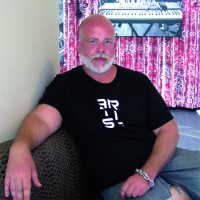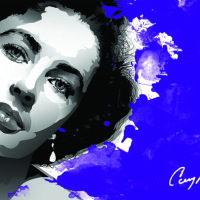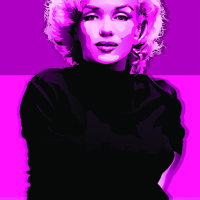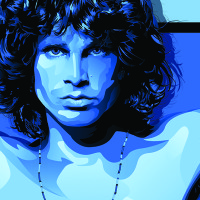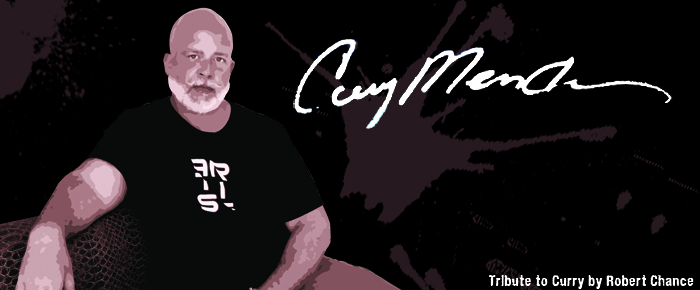
By Angela Valente Romeo
Sometimes we choose a path that does not suit us but seems to be a logical choice. When I was contemplating colleges I was considering art school. My father, whose advice I rarely took, said, “Art school? You will starve to death!!” So I became a lawyer, who could never leave the allure of the arts. I eventually gave up suits for artist garb. Poorer? Yes! Happier? Immensely! And so it seems that Curry Mendes’s journey to art is similar.
Attempting to honor his father’s wishes by not attending fine art school, Curry attended the Ringling School of Art& Design majoring in Interior Design. While a student, a wise mentor told Curry that school does not make someone an artist, but it is the talent that lies within, and by doing art all the time “you will have all you seek.” “That,” said Curry, “was the best advice I have ever received in my life.”
The life of an artist is not always easy. Recognition does not always equate with economic solvency. Curry worked in digital illustrating and programming. With pragmatism and passion, Curry continued to create. But the events of 9/11/2001, for Curry, like so many, were a push into reality. Curry realized that life is fragile and passion waits for no person. With renewed purpose and new found personal freedom, Curry pursued his art in earnest.
“My art is my life and with that I have no boundaries. No rules. No limitations. My art is my joy,” said Curry. “I tell myself everyday how blessed I am to do what I do.”
For Curry acceptance of his art has not been easy. “I work in the digital realm where the array of colors is endless, the possibilities for design are endless and where the work is as unique as any traditional medium. Despite all that digital art has been looked down upon by parts of the artistic communities,” noted Curry. “The perception of digital medium is changing.”
Digital work is often referred to as a giclée. Giclée was coined in 1991, by printmaker Jack Duganne, to denote fine art digital prints made on inkjet printers. “Beginning in the 1990’s all digital work that was outputted was called giclée. The term has an almost pejorative connotation as the early giclées had some technical issues. But the technology is always changing and digital out-put has improved with better archival inks and papers. Being lumped in with the generic term did hamper early acceptance of my work.”
“I found it odd that the subject matter of my work, portraits, was widely accepted by my process was not. The work I create on a computer is art, my art. Initially galleries rejected my work because of my process. It was never the subject matter, just the process! At one point I auditioned for a reality show that focused on art. I was being considered until they learned the work was digitally created. It was frustrating but I was not deterred.”
In fact digital art, like street or urban art, has found a home in galleries across the world. Curry joins a list of well-respected artists, such as Deborah Oropallo, Natalie Shau, and Alberto Seveso.
“I was also inspired by the work I saw at the Dia: Beacon, in Beacon New York. I grew up in Beacon. That museum expanded my knowledge of what is art!”
The Dia: Beacon occupies a former Nabisco box-printing factory. It houses a collection of art from the 1960s to the present. The Dia: Beacon focuses on single-artist, site-related presentations. The galleries were each designed specifically for the presentation of one artist’s work.
“For me the Dia: Beacon is contemporary art. It freely embraces the term contemporary and it does not prejudge the value of the art. It allows the art to exist. For someone like me, working in a young medium, it is encouragement,” noted Curry.
“I originally began doing portraits of everyday people and used them to tell a story, sadness, joy, depression, hope. I started focusing on celebrity portraitist for several reasons. Firstly, in a new medium a familiar subject seems to make the process more acceptable. Secondly, the Palm Springs area is the home and play ground to many celebrities. I researched and made a list of 35 who had a true connection to the area.”
Curry’s work includes images of Marilyn Monroe, Elizabeth Taylor, Clark Gable, Lucille Ball and Desi Arnaz. “Because of my use of digital art, the finished pieces can be any size and range from 7 feet by 4 ½ feet to 36 inches by 36 inches. I can take my celebrity and color it in the color I feel. For example, Luci and Desi are in pink. To me pink is love.”
“Do I care if my art is considered art? Well, I make art. I was advised to just make art and not to worry about the medium. I am pleased to see that others embrace what I do. So do I care? No because I know what I do is accepted. And that is all an artist can do – be accepted.”
Curry is showing at the art exhibition, at “Hollywood Glam” at UCR/Palm Desert Campus. The show runs through February 26, 2016. Curry’s work may also be seen at the popular restaurant Lulu’s in Palm Springs. His newly revamped website www.currymendes.com showcases Curry’s portrait and other work.
“I am not afraid of digital. I am not afraid of art. I am an artist creating art. I live large and enjoy who I am, an artist.”



































